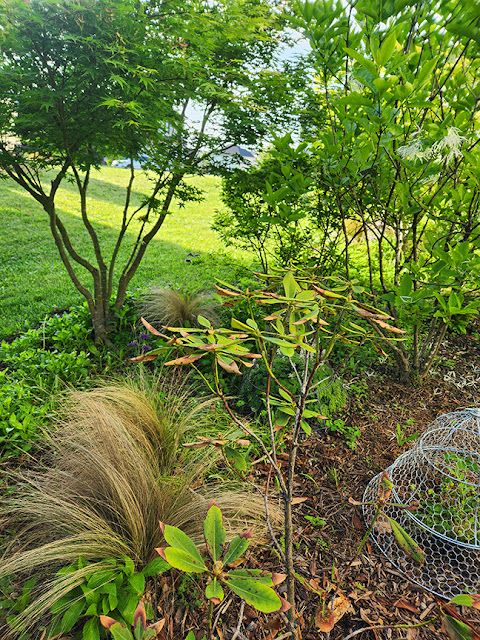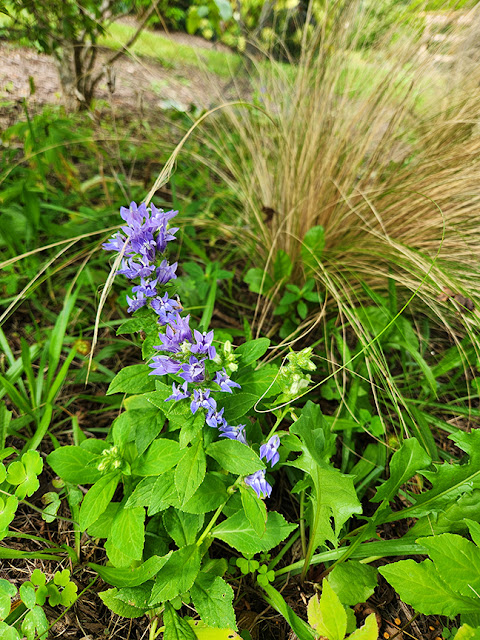 |
Peony 'Bartzella'
|
 |
Peony 'Bartzella' in the "Little Indians" bed
|
It's raining here today in my Zone 6b Virginia garden, a soft and gentle drizzle making our fields and gardens so green and lush... Bloom Day is hosted by Carol Michel's May Dreams Garden Blog on the 15th of every month. Happy May 2024 Bloom Day!
My 'Bartzella' peony is in its full glory right now, and holding up well in the rain, for which we're so grateful. Last year I separated the old-fashioned iris behind it, but this year's blooms have been very disappointing.
 |
Iris 'Victoria Falls' with double flowering quince beyond.
|
 |
Purple Dutch iris with Sambucus 'Black Lace'
|
My irises are just finishing their display for the year, although some of the late varieties are still blooming; now the peonies are coming into their own. 'Duchesse de Nemours' in the Herb bed is just starting to open.
 |
Peony 'Duchesse de Nemours'
|
A flowering spike of the Texas yucca (Hesperaloe parviflora) I planted two years ago has appeared, I'm looking forward to seeing the flowers close-up. The spike is impressive in height thus far, let's hope the flowers are equally pleasing.
 |
Flower bud of Hesperaloe parviflora
|
Both of my Ninebark trees are blooming at this time, as is the Asian dogwood, which has recently been re-named Benthamia kousa, replacing the old genus name of Cornus.
 |
Ninebark tree 'Coppertina' (Physocarpus opulifolius)
|
 |
"Coppertina' with Kousa dogwood behind
|
 |
Kousa dogwood (Benthamia kousa) in bloom
|
The native iris (Iris versicolor) under the Redbud tree has produced one bloom thus far; last year it flowered so abundantly, I don't expect anything as profuse this year. The Verbascum 'Southern Charm' was looking much better before the rains, but what can one do? The Salvia 'Pink Profusion' near it was a new addition last fall, but it's not living up to its name yet.
 |
Iris versicolor
|
 |
Verbascum 'Southern Charm' with Salvia 'Pink Profusion'
|
The other Ninebark tree 'Amber Jubilee' near the Japanese maple 'Amber Ghost' complement each other so nicely. Beyond are some Willowleaf starflowers (Amsonia tabernaemontana) with the Anise Hyssop I planted last year, a sedge, and some white Salvia.
 |
Ninebark tree 'Amber Jubilee' with Japanese maple 'Amber Ghost'
|
 |
Amsonia tabernaemontana
|
I have another variety of Amsonia--hubrichtii--growing in the "Little Indians" bed, but these don't seem to be blooming as well as in previous years--they probably need to be broken up and re-planted farther away from the Korean boxwood. They seem to be re-seeding themselves as well.
 |
Amsonia hubrichtii
|
The bed on the west side of the house has some nice color--Catmint, Salvia 'May Night,' red Dianthus and a yellow flower that I've forgotten the name of. The Clematis 'Appleblossom' climbing up to the deck still has some blooms
 |
Bed on the west side of the house.
|
 |
West side of the house with new backyard vegetable enclosure.
|
Another late-blooming bearded iris variety, 'Wine Festival' offered just one flowering spike this year.
 |
Iris 'Wine Festival'
|
The pink peony is getting ready to open in the front, by the driveway. The purple Dutch iris are just starting to fade as the Allium moly gets going.
 |
Pink peony with Allium and irises beyond.
|
 |
Dutch iris and Allium moly
|
My front yard appears to have the fewest flowers at the moment--the last flower of a lone white bearded iris spike and the red 'Double Knockout' rose. The Double Knockout rose was decimated by sawfly larvae, and I didn't see them until it was too late--the poor rose looks as if it had bronze foliage, but it's only the skeletonized leaves.
 |
White iris and red 'Double Knockout' rose
|
A blast of color is provided by the last of the red Amaryllis flowers opening on the porch.
 |
Red Amaryllis buds.
|























































